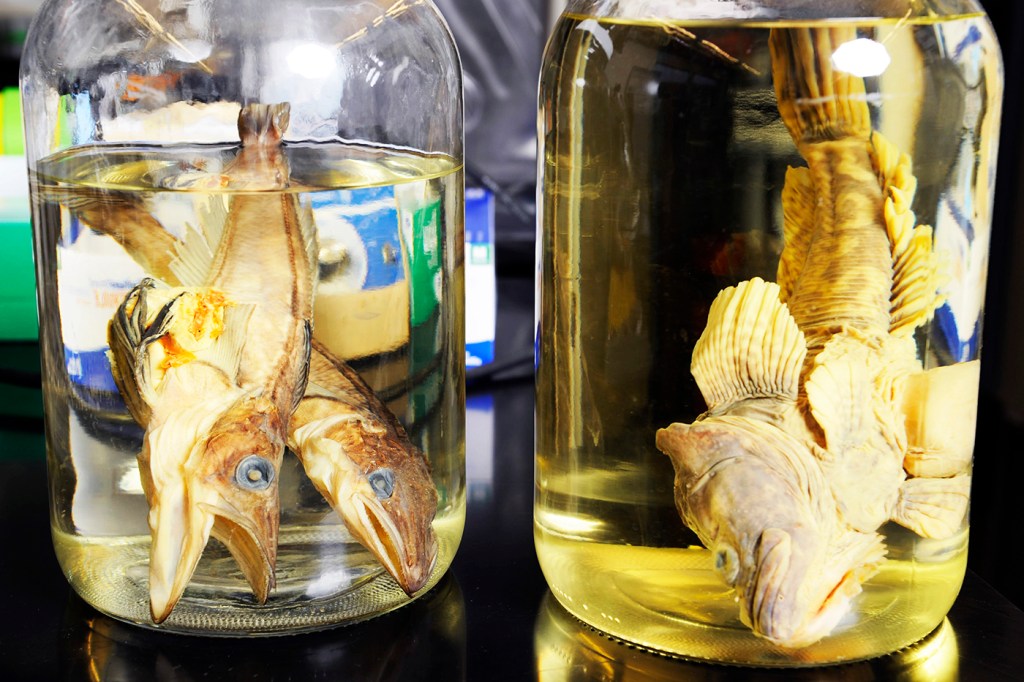Sequencing the genome of the blackfin icefish might help us better understand anemia, osteoporosis, and other ailments

Resting on the seafloor of the cold, dark waters around Antarctica is a scaleless fish with a large, crocodilian head, ghostly pale skin, and antifreeze running through its opalescent white blood.
This is the blackfin icefish, and its unique adaptations to its frigid habitat could provide breakthroughs in human medicine, says Northeastern professor H. William Detrich, a leader of an international collaboration that has recently sequenced the genome of this bizarre species.
“I’m fascinated by the fact that you can find organisms in nature who have traits that work really well for them,” says Detrich, “but the same trait in humans is a disease.”
In order to thrive in the freezing Antarctic waters, the icefish has evolved a number of seemingly detrimental traits. Without scales, it has little armor to protect itself, and its skeleton is so fragile that it’s nearly transparent because of a lack of calcium. In humans, that deficiency can lead to osteoporosis.
But perhaps the most unlikely adaptation is the blackfin icefish’s complete lack of red blood cells and hemoglobin—things vital for the survival of any other vertebrate.
Red blood cells, and the hemoglobin they contain, circulate oxygen through the body. Out of roughly 65,000 known species of vertebrates, only the 16 species of icefish lack these structures. Without them, icefish blood can carry only 10 percent of the oxygen found in the blood of other fish.
For humans, the lack of sufficient healthy red blood cells or hemoglobin is a serious medical condition called anemia. For a fish that resides in ice-cold water, the mutation may have been a boon.
Extreme cold causes red blood to thicken, the way maple syrup does when it’s left in the fridge, Detrich says. The lack of red blood cells means icefish blood is particularly thin, making it easier to circulate in the cold.
“With the information that is available in the genome of this icefish, and of other icefishes that we’re involved in sequencing, we may be able to drill down on the question of how this unusual trait developed,” says Detrich, who worked with a videographer to translate their research into an educational video series called Expedition Antarctic. “The loss of red blood cells wasn’t without bad consequences for the icefish. It just wasn’t lethal.”

Northeastern professor H. William Detrich. Photo by Matthew Modoono/Northeastern University
To compensate for its state of perpetual anemia, the icefish has had to evolve rather drastically. Losing its scales allows oxygen to enter the bloodstream directly through the skin. Extra-large gills and an oversized heart pull additional oxygen out of the water and circulate it faster. Expanded capillaries help to transfer that oxygen into tissues.
These adaptations, along with many others, are written into the animal’s genetic code. In the process of sequencing the icefish genome, the researchers also found that fish had an excess of genes responsible for creating proteins to keep it from freezing as it ingests ice crystals from the surrounding water.
“The icefish has a lot more antifreeze genes than have been reported for any antarctic fish species to this point,” Detrich says. “They also have a lot more of the proteins involved in protecting the egg as its developing.”
Other genes were more scarce, such as the ones that regulate body processes in response to the daylight cycle.
Researchers don’t yet know what all these changes mean. But investigating the icefish genome could help scientists better understand human health issues associated with night-shift workers, osteoporosis, and various forms of anemia.
“The solutions they’ve achieved may be transferable to the world of biomedicine,” Detrich says.
Not bad for an enigmatic fish just struggling to survive in the coldest depths of the ocean.
For media inquiries, please contact Shannon Nargi at s.nargi@northeastern.edu or 617-373-5718.





